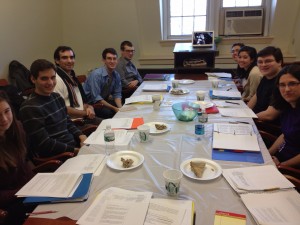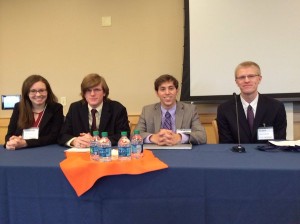By Gregory Chin ’18

This past Tuesday Natasha Meyer ’16 visited the Introduction to Archaeology class taught this semester by Prof. Ellen Perry. Natasha talked to us about her senior thesis work and research concerning the micro-excavations of the Kylindra infant cemetery on the Greek island of Astypalaia. Her goal was to foster an ongoing dialogue and understanding between cultural anthropology and biological archaeology concerning how and why the funerals in the Kylindra cemetery occur. That’s some pretty intriguing stuff, and it is hard to believe that a current student is doing such groundbreaking work — part of the average day and life of a Holy Cross student, I guess.
Natasha first delved into the logistical background behind Astypalaia, addressing its population, history, and location. After establishing this foundation, she went about dating the cemetery by using information gained from items found during the excavation, such as amphorae (tall jars) and other burial pottery in which the remains had been placed. This connected almost seamlessly to what we were doing in class (and what we would have to do on a slide exam the following class day!).
She also explained how a “micro” excavation worked, and how members of a field school would have to carefully deal with the infants’ remains, trying to keep them intact and in their exact position before taking pictures and measurements. In addition to this, Natasha acknowledged that, biologically speaking, it would be difficult to uncover the cause of death for the approximately three thousand infants found so far.
However, it would be too easy to stop there, to have an “oh well, we tried” moment that Holy Cross students refer to jokingly in the face of all of our studies. What was perhaps the most interesting point of Natasha’s presentation was her possible explanations for why the infants were buried here at Astypalaia, and in the way they were. Natasha considered and then cast doubt on both infanticide and the existence of a widespread plague or disease as explanations for the many burials in this cemetery. Instead, she argued that the evidence hinted at the possibility of Astypalaia serving as a birthing or healing sanctuary.
Furthermore, according to Natasha’s research, the placement of the babies within the pots perhaps suggested a symbolic rebirth of the infant into the afterlife, a movement proposed to “fix the universe” according to Natasha, Prof. Perry, and her thesis director Prof. Rodgers of the Department of Sociology and Anthropology, who was also present for the presentation.
I do know one thing, though. Natasha’s conversation has definitely “fixed” what would have been a normal Tuesday afternoon after class, filling it with questions, answers, and the notion that perhaps the human body is an artifact itself, revealing not only who we are, but who we are in the context of our culture and communities as well. It was an amazing experience, and I can tell that Natasha will go on to do amazing things in the future.















